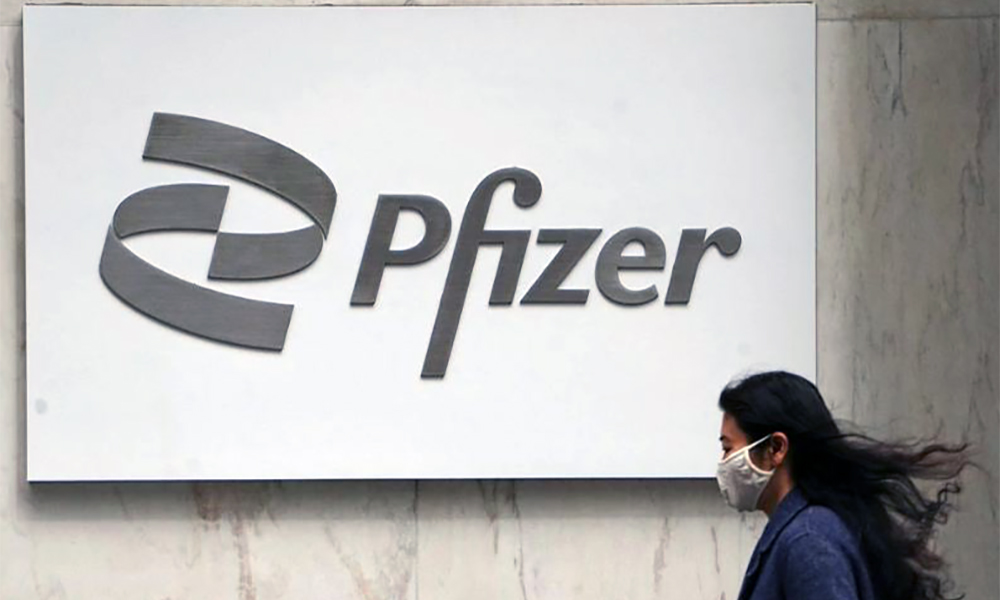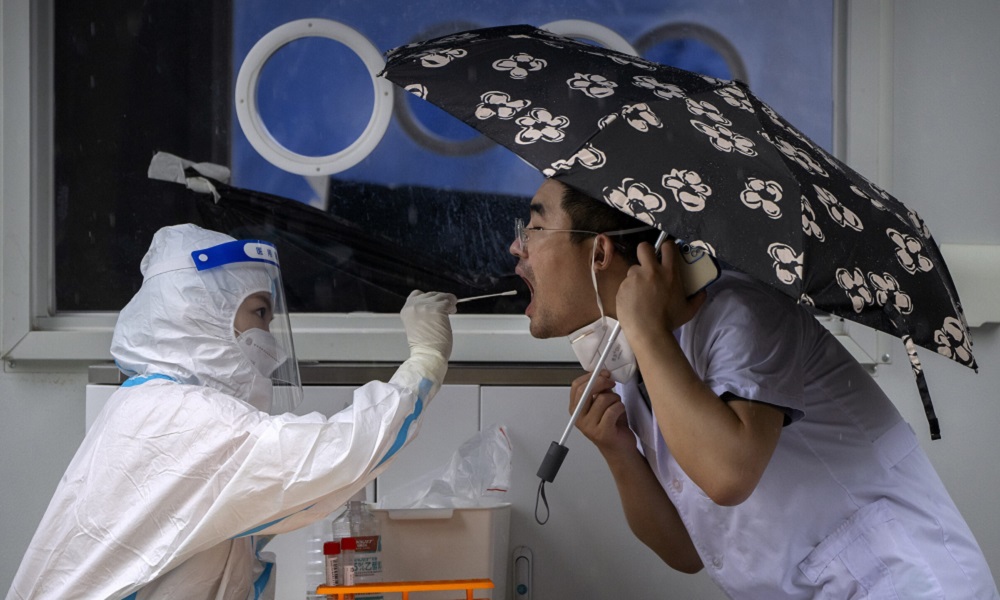COVID-19
U.S. considers authorization of first COVID vaccine for children under 5

U.S. regulators are considering the first COVID-19 vaccine for children under the age of 5, the only age group not yet eligible for the shots, after Pfizer Inc (PFE.N) and BioNTech SE began the regulatory approval process on Tuesday, Reuters reported.
A decision is expected as soon as this month.
The companies said they began submitting data for an emergency use authorization even though they did not meet a key target in their clinical trial of 2- to 4- year olds. They are submitting the data at the request of the U.S. Food and Drug Administration in order to address an urgent public health need in the age group, they said.
The arrival of a vaccine for younger children could help harried parents who have had to contend with quarantines and closures of pre-schools and daycare centers, read the report.
“Having a safe and effective vaccine available for children in this age group is a priority,” acting FDA Commissioner Janet Woodcock said. She said the agency asked for the application because of the recent Omicron surge.
The FDA said an outside committee of expert advisers would meet on Feb. 15 to discuss the authorization. If that goes forward, the U.S. Center for Disease Control and Prevention also needs to sign off on how the vaccinations will be implemented, following a meeting of its own advisers. Those meetings have tended to follow within a week or so of FDA decisions.
According to Reuters the drug companies said they are asking the FDA for authorization of the first two doses of a planned three-dose regimen.
“If two doses are authorized, parents will have the opportunity to begin a COVID-19 vaccination series for their children while awaiting potential authorization of a third dose,” Pfizer Chief Executive Albert Bourla said.
He said the company believes three doses of the vaccine will be needed “to achieve high levels of protection against current and potential future variants.”
The companies expect to complete submitting data to the FDA in the coming days, with data on the third dose to follow.
Pfizer and BioNTech are testing a 3-microgram dose of the vaccine in the age group, compared with a 10-microgram dose in 5- to 11-year-olds and 30 micrograms for people aged 12 and older, Reuters reported.
The companies said they expect to have ample supply of the 3-microgram shots should the FDA authorize the vaccine.
EVIDENCE OF CLINICAL BENEFIT?
The move could speed up the inoculation timeline for this age group by months. If a third dose is eventually authorized, many children could already have begun the regimen. Pfizer is currently testing two doses three weeks apart, followed by a third dose at least eight weeks later.
In December, Pfizer said it was amending its clinical trial to test a three-dose version of the vaccine because the lower-dose generated an immune response in 2- to 4-year-olds that was inferior to the response measured in those aged 16 to 25. In 6- month- to 24-month-old children, the vaccine generated an immune response in line with 16- to 25-year-olds.
John Grabenstein, former executive director of medical affairs for vaccines at Merck, said he believes regulators should consider the vaccine as a two-dose course, rather than as the first two doses of a planned three dose regimen.
“I cannot think of any example ever where the FDA reached a regulatory decision without knowing the data from the end of the trial,” Grabenstein said. “I just can’t believe that they would authorize getting started without knowing what the third dose would do.”
But John Moore, a professor of microbiology and immunology at Weill Cornell Medical College, said the plan “sounds like a creative solution to a real problem, and there’s no safety implications, which would otherwise be a dealbreaker.”
The vaccine is already approved for emergency use in children in the United States as young as 5. It has full approval for adults.
The FDA also has authorized a third booster dose of the Pfizer/BioNTech shot for adults and children aged 12 and older. It gave the green light for a two-dose vaccine for children ages 5 to 11.
It remains unclear how many parents will choose to vaccinate their younger children.
Vaccinating children has been slow in the United States with only around 22% of 5- to 11 year-olds having received two shots since the campaign to inoculate that age group began in November, Reuters reported.
COVID-19
WHO declares end to COVID global health emergency

The World Health Organization said Friday that COVID-19 no longer qualifies as a global emergency, marking a symbolic end to the devastating coronavirus pandemic that triggered once-unthinkable lockdowns, upended economies and killed millions of people worldwide.
The announcement, made more than three years after WHO declared the coronavirus an international crisis, offers some relief, if not an ending, to a pandemic that stirred fear and suspicion, hand-wringing and finger-pointing across the globe, AP reported.
The U.N. health agency’s officials said that even though the emergency phase was over, the pandemic hasn’t finished, noting recent spikes in cases in Southeast Asia and the Middle East.
WHO says thousands of people are still dying from the virus every week, and millions of others are suffering from debilitating, long-term effects.
“It’s with great hope that I declare COVID-19 over as a global health emergency,” WHO Director-General Tedros Adhanom Ghebreyesus said.
“That does not mean COVID-19 is over as a global health threat,” he said, warning that new variants could yet emerge. Tedros noted that while the official COVID-19 death toll was 7 million, the real figure was estimated to be at least 20 million.
Tedros said the pandemic had been on a downward trend for more than a year, acknowledging that most countries have already returned to life before COVID-19.
He bemoaned the damage that COVID-19 had done to the global community, saying the pandemic had shattered businesses, exacerbated political divisions, led to the spread of misinformation and plunged millions into poverty.
When the U.N. health agency first declared the coronavirus to be an international crisis on Jan. 30, 2020, it hadn’t yet been named COVID-19 and there were no major outbreaks beyond China.
More than three years later, the virus has caused an estimated 764 million cases globally and about 5 billion people have received at least one dose of vaccine.
In the U.S., the public health emergency declaration made regarding COVID-19 is set to expire on May 11, when wide-ranging measures to support the pandemic response, including vaccine mandates, will end. Many other countries, including Germany, France and Britain, dropped most of their provisions against the pandemic last year.
When Tedros declared COVID-19 to be an emergency in 2020, he said his greatest fear was the virus’ potential to spread in countries with weak health systems.
Most recently, WHO has struggled to investigate the origins of the coronavirus, a challenging scientific endeavor that has also become politically fraught.
COVID-19
COVID-19 in Iran: Nearly 900 new cases, 24 deaths recorded

The Iranian health ministry announced on Sunday that more than 890 new cases of COVID-19 have been identified across the country during the past 24 hours, adding that 24 patients have died in the same period of time, Fars News Agency reported.
“A sum of 891 new patients infected with COVID-19 have been identified in the country based on confirmed diagnosis criteria during the past 24 hours,” the Iranian Health Ministry’s Public Relations Center said on Sunday, adding, “454 patients have been hospitalized during the same time span.”
The ministry’s public relations center said 611 people infected with COVID-19 are in critical condition.
COVID-19
China says 200 million treated, pandemic ‘decisively’ beaten

China says more than 200 million of its citizens have been diagnosed and treated for COVID-19 since it lifted strict containment measures beginning in November.
With 800,000 of the most critically ill patients having recovered, China has “decisively beaten” the pandemic, according to notes from a meeting of the ruling Communist Party’s all-powerful Politburo Standing Committee presided over by President and party leader Xi Jinping, AP reported.
China enforced some of the world’s most draconian lockdowns, quarantines and travel restrictions and still faces questions about the origins of the virus that was first detected in the central Chinese city of Wuhan in late 2019. Heavy-handed enforcement prompted rare anti-government protests and took a heavy toll on the world’s second-largest economy.
The official Xinhua News Agency quoted Xi as saying that policies to control the outbreak had been “entirely correct.” The abrupt lifting in November and December of the “zero COVID” policy that had sought to eliminate all cases of the virus led to a surge in infections that temporarily overwhelmed hospitals.
Case numbers have since peaked and life has largely returned to normal, although international travel in and out of China has yet to return to pre-pandemic levels.
China is now transitioning to a post-pandemic stage after a fight against the outbreak that was “extraordinary in the extreme,” Xinhua said.
The government will continue to “optimize and adjust prevention and control policies and measures according to the times and situations with a strong historical responsibility and strong strategic determination,” Xinhua said.
-

 Latest News3 days ago
Latest News3 days agoAfghan border forces prevent illegal entry of hundreds into Iran
-

 Latest News3 days ago
Latest News3 days agoPakistan summons Afghan diplomat over deadly attack in North Waziristan
-

 Latest News2 days ago
Latest News2 days agoAfghan health minister calls for medical cooperation between Kabul and New Delhi
-

 Latest News1 day ago
Latest News1 day agoAfghanistan signs 30-year deal for marble mining in Daikundi
-

 Latest News3 days ago
Latest News3 days agoJapan allocates nearly $20 million in humanitarian aid for Afghanistan
-

 Latest News3 days ago
Latest News3 days agoKarzai urges reopening of girls’ schools and universities for Afghanistan’s bright future
-

 Health5 days ago
Health5 days agoAfghanistan seeks India’s support in standardizing traditional medicine
-

 World5 days ago
World5 days agoUS readies new Russia sanctions if Putin rejects peace deal, Bloomberg News reports
























